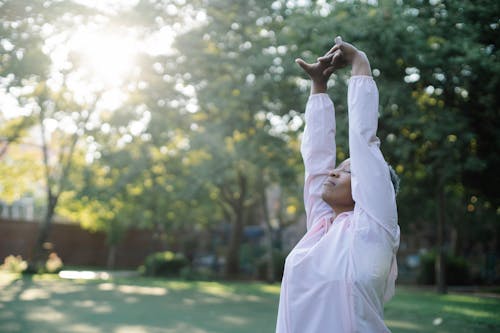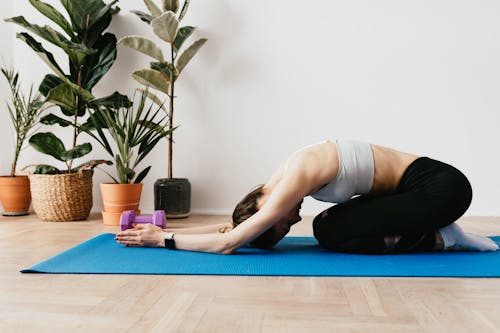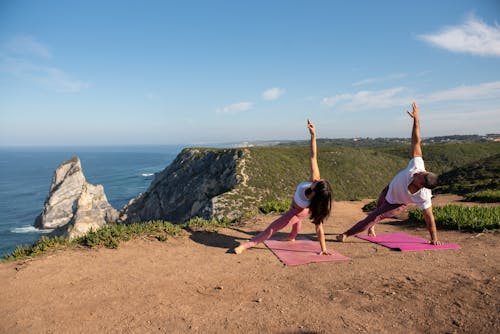
Many people start off their day by waking up with stiffness and pain. Morning stretches are a very healthy habit to adopt. As our lifestyles become more and more sedentary, neck and back pain is becoming more prevalent. Nearly everyone has heard about the benefits of stretching before and after a workout, but few realize how stretching in the morning can improve their health.
“While sleeping, the muscles of our bodies can become stiff and less mobile. Stretching first thing in the morning will help prepare the body for whatever it may need to do during the day and also relieve tension and discomfort from the muscles that may be affecting one’s quality of life,” says TJ Mentus, a conditioning and mobility specialist. “Stretching in the morning is important in order to maintain healthy joint function as well as helping the body to wake up.”
Additionally, a good stretching and mobility routine first thing in the morning gets the blood flowing, helps wake you up, and heightens your mental alertness.
With those benefits in mind, including the added benefit of alleviating body pain and improving posture, let’s discuss how to stretch properly. In this article we’ll take a look at a few morning stretches that can help you start your day on a good note.
The first thing we’ll discuss is the mobility required for proper stretching.

Flexibility and Mobility
Stretching and mobility and two terms that are sometimes used interchangeably, but actually refer to two different movements.
Stretching is a movement to increase flexibility. Stretching can be described as dynamic, meaning some movement is involved, or static, meaning the stretch is held for a certain length of time.
Mobility, on the other hand, is a movement that incorporates both flexibility and strength.
Stretching and mobility complement each other and contribute greatly to your overall fitness. A good stretch and mobility routine will increase your range of motion, improve your ability to perform other exercises and decrease the risk of injury.
It’s not a good idea to stretch ‘cold’ muscles, meaning muscles that haven’t been prepared for activity with a proper warm-up. Stretching cold muscles can cause strains or tears. Warming up can consist of arm circles, walking, leg swings, or any other kind of light, non-strenuous movement that gets the blood flowing to muscle tissue.
In order to get the maximum benefits from stretching, it’s important to practice good form and to know your limits. Holding a stretch anywhere from 10 seconds to 3 minutes is a good rule of thumb. Keep your breathing even throughout the stretch.

Stretches to Alleviate Neck Pain
TJ recommends beginning with neck CARs. “A CAR(Controlled Articular Rotation) is basically moving the joint through its full range of motion. To perform a neck CAR you will start with the neck in a neutral position. Pull the chin down to your chest. The chin will be leading the neck through the stretch. Next, turn your head to the side, bringing the chin to the shoulder. From there, tilt the head backwards. Then in as big of a circular motion as you can, reach the chin up and around to the other shoulder and then sweep it back to the front, finishing with it tucked on your chest. Perform these very slowly and think about using the muscles around the neck to pull the head in this circular motion. Do 3-5 in each direction, clockwise and counterclockwise.”
Other neck stretches include:
- Forward and backward tilt
- Side to side tilt (imagine bringing your ear to your shoulder)
- Trapezius stretch

Stretches to Alleviate Back Pain
Back pain can be alleviated by strengthening your core, including the muscles in your back. Many of us spend the early part of our day seated, so getting blood to our muscles with a good stretching routine first thing in the morning can help our bodies prepare for what the day has in store.
Joshua Lafond from Healthy Gym Habits likes to suggest the Cobra Pose to his clients.
“This is a great beginner pose that comes from the yoga world; however, it’s equally a great stretch to specifically target back muscles. Start by lying with your stomach on the floor and having your legs extended behind you a few inches apart from each other. Put the palm of your hands under your shoulders while pointing your fingers towards the top of the mat. Your elbows should be tucked in and hugging the sides of your body. Using the tops of your feet and pubic bone, press down into the mat. Inhale while simultaneously lifting your chest and head off the floor. Ensure you’re still keeping your lower rib cage on the floor. Push your shoulders back and your chest forward to really feel the backbend.”
Other great back stretches include:
- Thread the needle: This gently stretches your thoracic spine and shoulders.
- Supine Twist: Improves flexibility and mobility in the lower back.
- Flexion Stretch: Also referred to as a knee-to-chest stretch, you should be able to feel this stretch across the mid to low back.
While stretching the low back, it’s important to include stretches that target the hip flexors and glutes as well. Such stretches include
- Piriformis Stretch: The piriformis is a muscle near the top of the hip joint, deep in the buttocks. When this muscle is tight or inflamed, it can cause sciatic-like pain.
- Kneeling Hip Flexor Stretch: This can be done a few times throughout the day to keep your hip flexor from tightening up, which is a common problem for people who spend a lot of time sitting.
- Child Pose: Another stretch from the yoga world, this stretch will benefit your low back, hips and knees.

Full Body Stretches and Mobility
Everyone’s body is different, and there are countless stretches that target individual muscle groups. However, in order to reap the full benefits of a morning stretching routine, it’s a good idea to incorporate movements that will work muscle groups throughout your whole body.
Many people benefit from starting their day with the following stretches:
- Worlds Greatest: From your neck to your calves, this stretch (when performed properly) is a great follow-up to lower back or hip flexor stretches.
- Cat-Cow: This is a gentle stretch that wakes up the front and back body.
- Sun Salutation: The most well-known yoga flow, a sun salutation is a gentle flow that targets multiple muscle groups, improves flexibility and increases blood flow. As with many yoga poses, the main benefit here is that we are combining static and dynamic stretches with movement, improving both flexibility and mobility.
- Forward Fold: This stretches the back body including the low back, glutes, hips, hamstrings and calves. It may seem simple enough, but be mindful to keep your core engaged in order to prevent putting excessive pressure on your lower back.
Flexibility, like anything fitness-related, takes time and patience to build. A CircleDNA test can tell you if you have a genetic predisposition for greater flexibility.
Don’t force flexibility. Stretch within your limits and try to notice the subtle ways in which your body is benefiting from stretching: balance and coordination are two other areas that can improve after following a stretching routine. Don’t force yourself to stretch deeper or hold for longer if you’re experiencing pain, and don’t be discouraged if you feel like your flexibility isn’t noticeably better right away; some people are just naturally more flexible than others.
If, while stretching, you find that your range of motion and mobility are unexpectedly inhibited, make an appointment with a kinesiologist or physical therapist. These professionals can show you how to stretch properly, and address any causes for p0oiuoor range of motion.






Comments are closed.